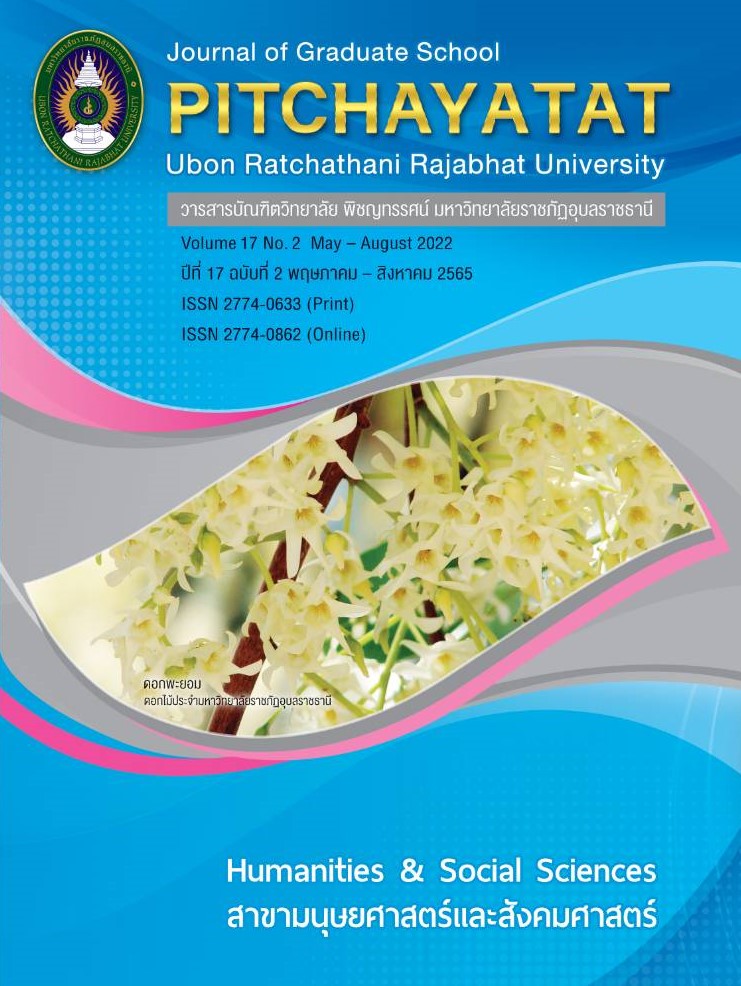การพัฒนาความคิดสร้างสรรค์ทางดนตรี โดยใช้กิจกรรมการเรียนการสอนตามแนวคิดของโคดายสำหรับนักเรียนชั้นประถมศึกษาปีที่ 4
คำสำคัญ:
ดนตรี, ความคิดสร้างสรรค์ , การเรียนการสอนบทคัดย่อ
การวิจัยนี้มีวัตถุประสงค์เพื่อการพัฒนาความคิดสร้างสรรค์ทางดนตรี โดยใช้กิจกรรมการเรียนการสอนตามแนวคิดของโคดายสำหรับนักเรียนชั้นประถมศึกษาปีที่ 4 ผู้วิจัยใช้รูปแบบการวิจัยเชิงปฏิบัติการ โดยมีคะแนนผ่านเกณฑ์ร้อยละ 70 ขึ้นไปกลุ่มเป้าหมายที่ใช้ คือ นักเรียนชั้นประถมศึกษาปีที่ 4 โรงเรียนบ้านหัวดอนขามสามัคคี อำเภอพนา จังหวัดอำนาจเจริญ ภาคเรียนที่ 2 ปีการศึกษา 2564 จำนวน 16 คน เครื่องมือที่ใช้ ได้แก่ 1) แผนการจัดการเรียนรู้จำนวน 7 แผน 2) แบบวัดความคิดสร้างสรรค์ทางดนตรี ข้อ 3) แบบบันทึกภาคสนาม วิเคราะห์ข้อมูลโดยการหาร้อยละ ค่าเฉลี่ย และสรุปผลเป็นความเรียง
ผลการวิจัยพบว่า
ผลการพัฒนาความคิดสร้างสรรค์ทางดนตรี โดยใช้กิจกรรมการเรียนการสอนตามแนวคิดของโคดายสำหรับนักเรียนชั้นประถมศึกษาปีที่ 4 พบว่า นักเรียนมีคะแนนการวัดความคิดสร้างสรรค์ทางดนตรีสูงกว่าเกณฑ์ร้อยละ 70 ขึ้นไป
เอกสารอ้างอิง
ณรุทธ์ สุทธจิตต์. กิจกรรมดนตรีสำหรับครู. กรุงเทพฯ: จุฬาลงกรณ์มหาวิทยาลัย, 2543.
ธวัชชัย นาควงษ์. การสอนดนตรีสำหรับเด็กตามแนวของคาร์ล ออร์ฟ กรุงเทพฯ: สำนักพิมพ์มหาวิทยาลัยเกษตรศาสตร์, 2547.
บุญชม ศรีสะอาด. การวิจัยเบื้องต้น. พิมพ์ครั้งที่ 7 กรุงเทพฯ:. สุวีริยาสาส์น, 2545.
ดาวน์โหลด
เผยแพร่แล้ว
รูปแบบการอ้างอิง
ฉบับ
ประเภทบทความ
สัญญาอนุญาต
ลิขสิทธิ์ (c) 2022 วารสารบัณฑิตวิทยาลัย พิชญทรรศน์ มหาวิทยาลัยราชภัฏอุบลราชธานี

อนุญาตภายใต้เงื่อนไข Creative Commons Attribution-NonCommercial-NoDerivatives 4.0 International License.
บทความทุกเรื่องได้รับการตรวจความถูกต้องทางวิชาการโดยผู้ทรงคุณวุฒิภายนอกอย่างน้อย 3 คน ความคิดเห็นในวารสารพิชญทรรศน์เป็นความคิดเห็นของผู้นิพนธ์มิใช่ความคิดเห็นของผู้จัดทำ จึงมิใช่ความรับผิดชอบของวารสารพิชญทรรศน์ และบทความในวารสารพิชญทรรศน์สงวนสิทธิ์ตามกฎหมายไทย การจะนำไปเผยแพร่ต้องได้รับอนุญาตเป็นลายลักษณ์อักษรจากกองบรรณาธิการ






